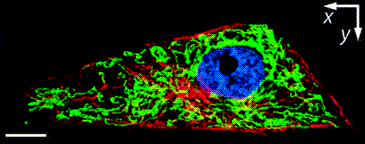The Mitochondria Close-Up and in Color
The mitochondria, often called “the powerhouses of the cell” in biology textbooks, are one of the coolest parts of the cell. They’re the primary site of metabolism and even have their own genes, probably because our ancestral cells acquired this organelle by engulfing another organism. The mitochondria have also been implicated in aging and the development of diseases such as cancer.

Now thanks to researchers at the Max Planck Institute, we can get a closer look at them. The resolution of this image, which shows a kangaroo mitochondrion, is about 30 nanometers; the white scale bar is 10 micrometers. Proteins in the cytoskeleton were labelled red; the blue ball is the nucleus; and the green lines make up the organelle’s membrane. This is the first time that the folds in this membrane, called cristae, have been seen at this level of detail. The cristae are the major site of metabolism in the cell.
Led by Stefan W. Hell, the German researchers are one of many groups working on improving optical microscopes to get around physical limits that have made it impossible to use light to see cells at super-high resolution. Techniques including electron microscopy offer high resolution but require killing cells. Imaging with light should allow biologists to watch the molecular workings of living cells, leading to new insights into the molecular origins of disease. In the case of the mitochondria, these studies should lead to better understanding of aging and of metabolic disorders.
This work was published online in the journal Nano Letters.
Keep Reading
Most Popular
Large language models can do jaw-dropping things. But nobody knows exactly why.
And that's a problem. Figuring it out is one of the biggest scientific puzzles of our time and a crucial step towards controlling more powerful future models.
How scientists traced a mysterious covid case back to six toilets
When wastewater surveillance turns into a hunt for a single infected individual, the ethics get tricky.
The problem with plug-in hybrids? Their drivers.
Plug-in hybrids are often sold as a transition to EVs, but new data from Europe shows we’re still underestimating the emissions they produce.
Google DeepMind’s new generative model makes Super Mario–like games from scratch
Genie learns how to control games by watching hours and hours of video. It could help train next-gen robots too.
Stay connected
Get the latest updates from
MIT Technology Review
Discover special offers, top stories, upcoming events, and more.